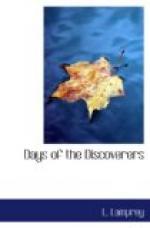Francis had asked Verrazzano to come to Moulins because, from what he had heard, it seemed to him that here was a man who could take care of himself and hold his tongue, and he liked such men. The experience reminded the Florentine of the great days of the Medici. Charles de Bourbon’s palace at Moulins was fit for a king. Unlike most French chateaux, which were built on low lands among the hunting forests, it stood on a hill in a great park, and was surrounded with terraces, fountains, and gardens in the Italian style. Moreover its furniture was permanent, not brought in for royal guests and then taken away. The richness and beauty of its tapestries, state beds, decorations, and other belongings was beyond anything in any royal palace of that time. The duke’s household included five hundred gentlemen in rich suits of Genoese velvet, each wearing a massive gold chain passing three times round the neck and hanging low in front; they attended the guests in divisions, one hundred at a time.
The feasting was luxurious, and many of its choice dishes were supplied by the estate. There were rare fruits and herbs in the gardens, and a great variety of game-birds and animals in the park and the forest. But there were also imported delicacies—Windsor beans, Genoa artichokes, Barbary cucumbers and Milan parsley. The first course consisted of Medoc oysters, followed by a light soup. The fish course included the royal sturgeon, the dorado or sword-fish, the turbot. Then came heron, cooked in the fashion of the day, with sugar, spice and orange-juice; olives, capers and sour fruits; pheasants, red-legged partridges, and the favorite roast, sucking-pig parboiled and then roasted with a stuffing of chopped meats, herbs, raisins and damson plums. There were salads of fruit,—such as the King’s favorite of oranges, lemons and sugar with sweet herbs,—or of herbs, such as parsley and mint with pepper, cinnamon and vinegar. For dessert there were Italian ices and confectionery, and the Queen’s favorite plum, Reine Claude, imported from Italy; the white wine called Clairette-au-miel, hypocras, gooseberry and plum wines, lemonade, champagne. There was never a King who could appreciate such artistic luxury more deeply than Francis I. This may be one reason for his warm welcome of Verrazzano, who seemed to be able to increase the wealth of his country and his King.
“I have had a very indignant visit from the Spanish ambassador,” said Francis when they were seated together in a private room. “He says that there has been piracy on the high seas, my Verrazzano.”
The Italian met the laughing glance of the King with a somber gleam in his own dark eyes. “Does one steal from a robber?” he asked. “Not a quill of gold-dust nor an ingot of silver nor a seed-pearl comes honestly to Spain. It is all cruelty, bribery, slavery. Savonarola threatened Lorenzo de’ Medici with eternal fires, prince as he was, for sins that were peccadilloes beside those of Spanish governors.”




